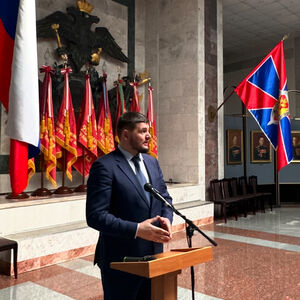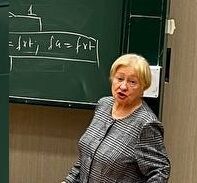150032 (732565)
Текст из файла
Nonlinear multi-wave coupling and resonance in elastic structures
Kovriguine DA
Solutions to the evolution equations describing the phase and amplitude modulation of nonlinear waves are physically interpreted basing on the law of energy conservation. An algorithm reducing the governing nonlinear partial differential equations to their normal form is considered. The occurrence of resonance at the expense of nonlinear multi-wave coupling is discussed.
Introduction
The principles of nonlinear multi-mode coupling were first recognized almost two century ago for various mechanical systems due to experimental and theoretical works of Faraday (1831), Melde (1859) and Lord Rayleigh (1883, 1887). Before First World War similar ideas developed in radio-telephone devices. After Second World War many novel technical applications appeared, including high-frequency electronic devices, nonlinear optics, acoustics, oceanology and plasma physics, etc. For instance, see [1] and also references therein. A nice historical sketch to this topic can be found in the review [2]. In this paper we try to trace relationships between the resonance and the dynamical stability of elastic structures.
Evolution equations
Consider a natural quasi-linear mechanical system with distributed parameters. Let motion be described by the following partial differential equations
(0)  ,
,
where  denotes the complex
denotes the complex  -dimensional vector of a solution;
-dimensional vector of a solution;  and
and  are the
are the  linear differential operator matrices characterizing the inertia and the stuffiness, respectively;
linear differential operator matrices characterizing the inertia and the stuffiness, respectively;  is the
is the  -dimensional vector of a weak nonlinearity, since a parameter
-dimensional vector of a weak nonlinearity, since a parameter  is small1;
is small1;  stands for the spatial differential operator. Any time
stands for the spatial differential operator. Any time  the sought variables of this system
the sought variables of this system  are referred to the spatial Lagrangian coordinates
are referred to the spatial Lagrangian coordinates  .
.
Assume that the motion is defined by the Lagrangian  . Suppose that at
. Suppose that at  the degenerated Lagrangian
the degenerated Lagrangian  produces the linearized equations of motion. So, any linear field solution is represented as a superposition of normal harmonics:
produces the linearized equations of motion. So, any linear field solution is represented as a superposition of normal harmonics:
 .
.
Here  denotes a complex vector of wave amplitudes2;
denotes a complex vector of wave amplitudes2;  are the fast rotating wave phases;
are the fast rotating wave phases;  stands for the complex conjugate of the preceding terms. The natural frequencies
stands for the complex conjugate of the preceding terms. The natural frequencies  and the corresponding wave vectors
and the corresponding wave vectors  are coupled by the dispersion relation
are coupled by the dispersion relation  . At small values of
. At small values of  , a solution to the nonlinear equations would be formally defined as above, unless spatial and temporal variations of wave amplitudes
, a solution to the nonlinear equations would be formally defined as above, unless spatial and temporal variations of wave amplitudes  . Physically, the spectral description in terms of new coordinates
. Physically, the spectral description in terms of new coordinates  , instead of the field variables
, instead of the field variables  , is emphasized by the appearance of new spatio-temporal scales associated both with fast motions and slowly evolving dynamical processes.
, is emphasized by the appearance of new spatio-temporal scales associated both with fast motions and slowly evolving dynamical processes.
This paper deals with the evolution dynamical processes in nonlinear mechanical Lagrangian systems. To understand clearly the nature of the governing evolution equations, we introduce the Hamiltonian function  , where
, where  . Analogously, the degenerated Hamiltonian
. Analogously, the degenerated Hamiltonian  yields the linearized equations. The amplitudes of the linear field solution
yields the linearized equations. The amplitudes of the linear field solution  (interpreted as integration constants at
(interpreted as integration constants at  ) should thus satisfy the following relation
) should thus satisfy the following relation  , where
, where  stands for the Lie-Poisson brackets with appropriate definition of the functional derivatives. In turn, at
stands for the Lie-Poisson brackets with appropriate definition of the functional derivatives. In turn, at  , the complex amplitudes are slowly varying functions such that
, the complex amplitudes are slowly varying functions such that  . This means that
. This means that
(1)  and
and  ,
,
where the difference  can be interpreted as the free energy of the system. So that, if the scalar
can be interpreted as the free energy of the system. So that, if the scalar  , then the nonlinear dynamical structure can be spontaneous one, otherwise the system requires some portion of energy to create a structure at
, then the nonlinear dynamical structure can be spontaneous one, otherwise the system requires some portion of energy to create a structure at  , while
, while  represents some indifferent case.
represents some indifferent case.
Note that the set (1) can be formally rewritten as
(2)  ,
, 
where  is a vector function. Using the polar coordinates
is a vector function. Using the polar coordinates  , eqs. (2) read the following standard form
, eqs. (2) read the following standard form
(3)  ;
;  ,
,
where  . In most practical problems the vector function
. In most practical problems the vector function  appears as a power series in
appears as a power series in  . This allows one to apply procedures of the normal transformations and the asymptotic methods of investigations.
. This allows one to apply procedures of the normal transformations and the asymptotic methods of investigations.
Parametric approach
As an illustrative example we consider the so-called Bernoulli-Euler model governing the motion of a thin bar, according the following equations [3]:
(4) 
with the boundary conditions

By scaling the sought variables:  and
and  , eqs. (4) are reduced to a standard form (0).
, eqs. (4) are reduced to a standard form (0).
Notice that the validity range of the model is associated with the wave velocities that should not exceed at least the characteristic speed  . In the case of infinitesimal oscillations this set represents two uncoupled linear differential equations. Let
. In the case of infinitesimal oscillations this set represents two uncoupled linear differential equations. Let  , then the linearized equation for longitudinal displacements possesses a simple wave solution
, then the linearized equation for longitudinal displacements possesses a simple wave solution
 ,
,
where the frequencies  are coupled with the wave numbers
are coupled with the wave numbers  through the dispersion relation
through the dispersion relation  . Notice that
. Notice that  . In turn, the linearized equation for bending oscillations reads3
. In turn, the linearized equation for bending oscillations reads3
(5)  .
.
As one can see the right-hand term in eq. (5) contains a spatio-temporal parameter in the form of a standing wave. Allowances for the this wave-like parametric excitation become principal, if the typical velocity of longitudinal waves is comparable with the group velocities of bending waves, otherwise one can restrict consideration, formally assuming that  or
or  , to the following simplest model:
, to the following simplest model:
(6)  ,
,
which takes into account the temporal parametric excitation only.
We can look for solutions to eq. (5), using the Bubnov-Galerkin procedure:
 ,
,
where  denote the wave numbers of bending waves;
denote the wave numbers of bending waves;  are the wave amplitudes defined by the ordinary differential equations
are the wave amplitudes defined by the ordinary differential equations
(7)  .
.
Here

stands for a coefficient containing parameters of the wave-number detuning:  , which, in turn, cannot be zeroes;
, which, in turn, cannot be zeroes;  are the cyclic frequencies of bending oscillations at
are the cyclic frequencies of bending oscillations at  ;
;  denote the critical values of Euler forces.
denote the critical values of Euler forces.
Equations (7) describe the early evolution of waves at the expense of multi-mode parametric interaction. There is a key question on the correlation between phase orbits of the system (7) and the corresponding linearized subset
(8)  ,
,
which results from eqs. (7) at  . In other words, how effective is the dynamical response of the system (7) to the small parametric excitation?
. In other words, how effective is the dynamical response of the system (7) to the small parametric excitation?
First, we rewrite the set (7) in the equivalent matrix form:  , where
, where is the vector of solution,
is the vector of solution,  denotes the
denotes the  matrix of eigenvalues,
matrix of eigenvalues,  is the
is the  matrix with quasi-periodic components at the basic frequencies
matrix with quasi-periodic components at the basic frequencies  . Following a standard method of the theory of ordinary differential equations, we look for a solution to eqs. (7) in the same form as to eqs. (8), where the integration constants should to be interpreted as new sought variables, for instance
. Following a standard method of the theory of ordinary differential equations, we look for a solution to eqs. (7) in the same form as to eqs. (8), where the integration constants should to be interpreted as new sought variables, for instance  , where
, where  is the vector of the nontrivial oscillatory solution to the uniform equations (8), characterized by the set of basic exponents
is the vector of the nontrivial oscillatory solution to the uniform equations (8), characterized by the set of basic exponents  . By substituting the ansatz
. By substituting the ansatz  into eqs. (7), we obtain the first-order approximation equations in order
into eqs. (7), we obtain the first-order approximation equations in order  :
:
 .
.
where the right-hand terms are a superposition of quasi-periodic functions at the combinational frequencies  . Thus the first-order approximation solution to eqs. (7) should be a finite quasi-periodic function , when the combinations
. Thus the first-order approximation solution to eqs. (7) should be a finite quasi-periodic function , when the combinations  ; otherwise, the problem of small divisors (resonances) appears.
; otherwise, the problem of small divisors (resonances) appears.
So, one can continue the asymptotic procedure in the non-resonant case, i. e.  , to define the higher-order correction to solution4. In other words, the dynamical perturbations of the system are of the same order as the parametric excitation. In the case of resonance the solution to eqs. (7) cannot be represented as convergent series in
, to define the higher-order correction to solution4. In other words, the dynamical perturbations of the system are of the same order as the parametric excitation. In the case of resonance the solution to eqs. (7) cannot be represented as convergent series in  . This means that the dynamical response of the system can be highly effective even at the small parametric excitation.
. This means that the dynamical response of the system can be highly effective even at the small parametric excitation.
In a particular case of the external force  , eqs. (7) can be highly simplified:
, eqs. (7) can be highly simplified:
(9) 
provided a couple of bending waves, having the wave numbers  and
and  , produces both a small wave-number detuning
, produces both a small wave-number detuning  (i. e.
(i. e.  ) and a small frequency detuning
) and a small frequency detuning  (i. e.
(i. e.  ). Here the symbols
). Here the symbols  denote the higher-order terms of order
denote the higher-order terms of order  , since the values of
, since the values of  and
and  are also supposed to be small. Thus, the expressions
are also supposed to be small. Thus, the expressions
 ;
; 
can be interpreted as the phase matching conditions creating a triad of waves consisting of the primary high-frequency longitudinal wave, directly excited by the external force  , and the two secondary low-frequency bending waves parametrically excited by the standing longitudinal wave.
, and the two secondary low-frequency bending waves parametrically excited by the standing longitudinal wave.
Notice that in the limiting model (6) the corresponding set of amplitude equations is reduced just to the single pendulum-type equation frequently used in many applications:
Характеристики
Тип файла документ
Документы такого типа открываются такими программами, как Microsoft Office Word на компьютерах Windows, Apple Pages на компьютерах Mac, Open Office - бесплатная альтернатива на различных платформах, в том числе Linux. Наиболее простым и современным решением будут Google документы, так как открываются онлайн без скачивания прямо в браузере на любой платформе. Существуют российские качественные аналоги, например от Яндекса.
Будьте внимательны на мобильных устройствах, так как там используются упрощённый функционал даже в официальном приложении от Microsoft, поэтому для просмотра скачивайте PDF-версию. А если нужно редактировать файл, то используйте оригинальный файл.
Файлы такого типа обычно разбиты на страницы, а текст может быть форматированным (жирный, курсив, выбор шрифта, таблицы и т.п.), а также в него можно добавлять изображения. Формат идеально подходит для рефератов, докладов и РПЗ курсовых проектов, которые необходимо распечатать. Кстати перед печатью также сохраняйте файл в PDF, так как принтер может начудить со шрифтами.
















